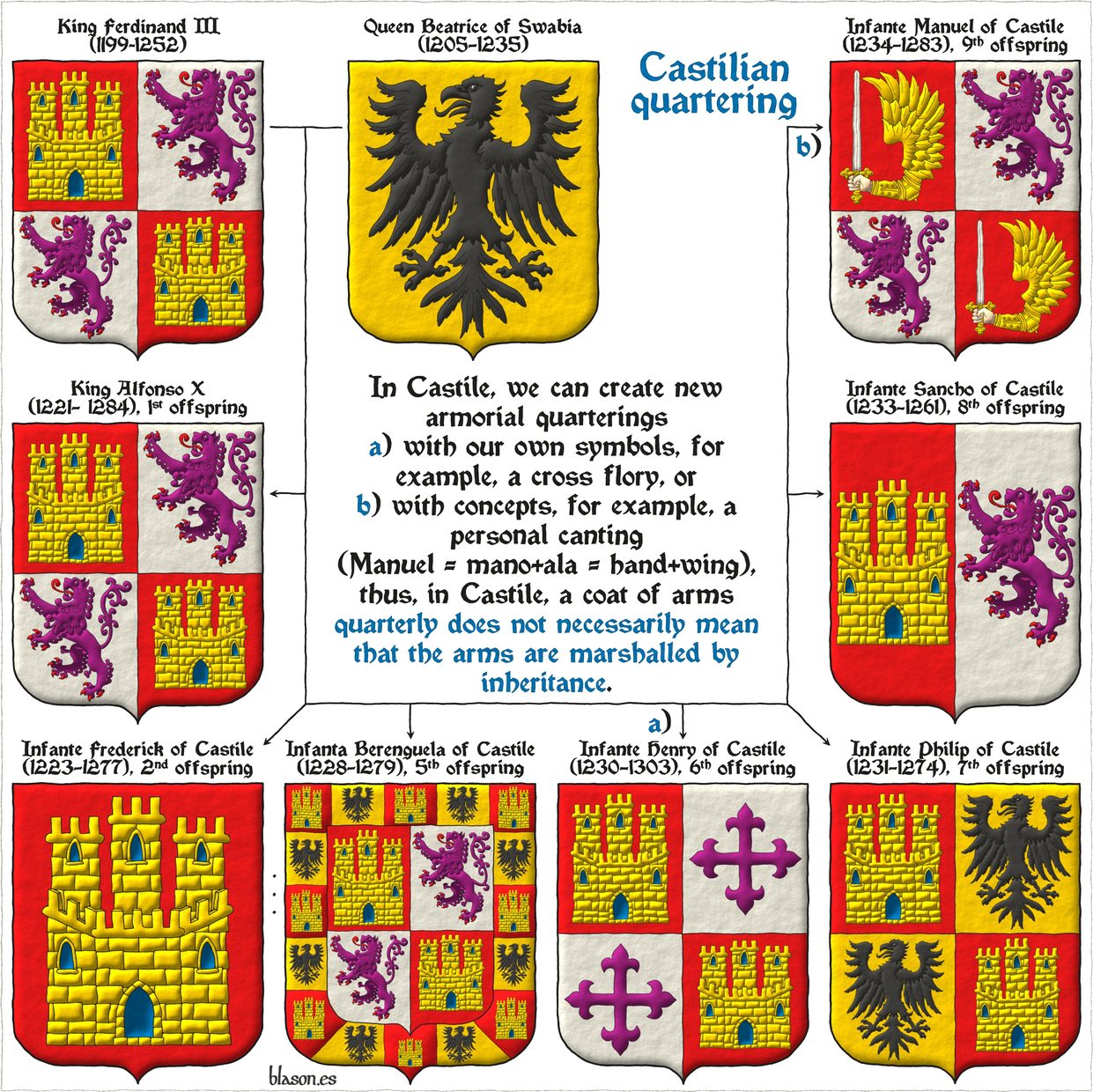
Infante Manuel of Castile, schema 3x4
In Castile, a coat of arms quarterly does not necessarily signify inheritance. This schema illustrates two practices: a) Quarterings can represent the mother in the 1st and 4th quarters and the father in the 2nd and 3rd, highlighting the prominence given to the maternal line by placing it in the most visible quarters. b) Quarterings can also include personal symbols and concepts, like canting arms, for example, «Manuel» =«mano» + «ala» = «hand» + «wing», combined with ancestral arms. This flexibility reflects Castilian heraldic traditions, where arms are not strictly marshalled by inheritance. The inclusion of maternal arms in the 1st and 4th quarters highlights how Castilian heraldry often elevates maternal heritage, differing from some other heraldic traditions. The previous commentary emphasizes the creative freedom in Castile, where quartering could incorporate personal symbols or canting arms without the constraints of inheritance or dominium. This flexibility aligns with Castilian culture, allowing heraldry to reflect personal identity, not just dynastic ties. Notably, the arms of Infante Enrique's use of a cross flory demonstrates this creative freedom, showcasing the ability to innovate within heraldry even in royal contexts. While this might seem unconventional compared to other heraldic systems, it is deeply rooted in Castilian tradition. All coats of arms in this schema have been emblazoned by me.
Blazon keywords: Argent, Purpure, Gules, Or, Azure, Sable, One, Quarterly, Lion, Rampant, Armed, Langued, Castle, Triple-towered, Port and windows, Masoned, Bordure, Compony, Eagle, Cross flory, Cross couped, Party per pale, Hand, Arm, Vambraced, Embowed, Winged, Sword, Point upwards and Hilted.
Style keywords: Outlined in sable, Illuminated and Ogee.
Classification: Personal, Kingdom of Castile and Leon, Interpreted, Design rationale, Schema, Boa and Coat of arms.
Bearer: Manuel of Castile, Infante.


Manuel of Castile, Infante
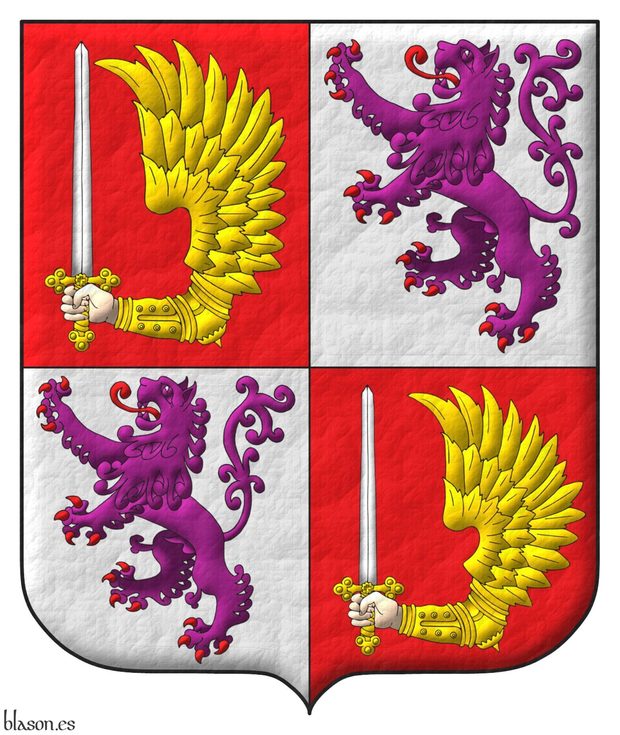
Quarterly: 1 and 4 Gules, a hand Carnation, embowed, vambraced and winged Or, holding a sword point upwards Argent, hilted Or; 2 and 3 Argent, a lion rampant Purpure, armed and langued Gules.
Escudo cuartelado: 1o y 4o de gules, una mano de carnación, doblada, armada, alada de oro, teniendo una espada alzada de plata, guarnecida de oro; 2o y 3o de plata, un león rampante de púrpura, armado y lampasado de gules.
Coat of arms painted by me, highlighted with lights and shadows, contoured in Sable, with an ogee external shape and with a leather finishing.
Coat of arms of the Infante Manuel of Castile, 1234–1283, 7th son of the King Ferdinand III of Castile, 1199-1252, and the Queen Beatrice of Swabia, 1205–1235. They are canting arms of «Manuel» ~ «manu–el» ~ «mano–ala» ~ «hand–wing». For this reason, I describe it as a hand with a wing and not as a wing with a hand. Another theory suggests that, since his maternal grandmother was Irene Ángelo, daughter of the Byzantine Emperor Isaac II Angelos, the 2nd and 3rd quarters derive from this lineage. However, this Byzantine emperor did not have a coat of arms in the Western heraldic sense, let alone one featuring an angel's wing wielding a sword. A synthetic theory could be proposed, combining the concept of canting arms with angelic symbolism, referencing his descent from the emperors of Byzantium, something that was undoubtedly of great importance to him. There are explanations about this in [Menéndez Pidal de Navascués, F.; 1982, pages 98-100]. And what's more important, they are not a quartering by inheritance; quarters 2nd and 3rd are inherited, but quarters 1st and 4th are conceptually invented, which opens up the creative field.
Blazon keywords: Gules, Or, Argent, Purpure, One, Quarterly, Hand, Arm, Vambraced, Embowed, Winged, Sword, Point upwards, Hilted, Lion, Rampant, Armed and Langued.
Style keywords: Outlined in sable, Illuminated, Ogee and Leather.
Classification: Personal, Kingdom of Castile and Leon, Interpreted, Design rationale, Boa and Coat of arms.
Bearer: Manuel of Castile, Infante.


Infante Manuel of Castile, ratios
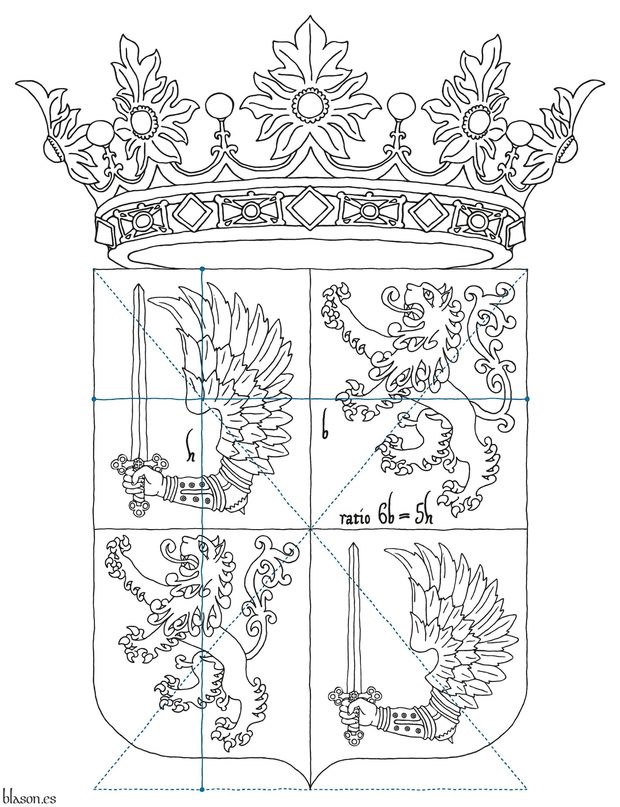
Quarterly: 1 and 4 Gules, a hand Carnation, embowed, vambraced and winged Or, holding a sword point upwards Argent, hilted Or; 2 and 3 Argent, a lion rampant Purpure, armed and langued Gules. Crest: An open royal crown.
Coat of arms of the Infante Manuel of Castile, 1234–1283, 7th son of the King Ferdinand III of Castile, 1199-1252, and the Queen Beatrice of Swabia, 1205–1235. This coat of arms has been delineated with proportions by me.
Blazon keywords: Gules, Or, Argent, Purpure, One, Quarterly, Hand, Arm, Vambraced, Embowed, Winged, Sword, Point upwards, Hilted, Lion, Rampant, Armed, Langued, Crest, Open royal crown and Crown.
Style keywords: Ratio, Outlined, Outlined in sable and Ogee.
Classification: Personal, Kingdom of Castile and Leon, Interpreted, Boa and Coat of arms.
Bearer: Manuel of Castile, Infante.


Infante Manuel of Castile, plain tincture
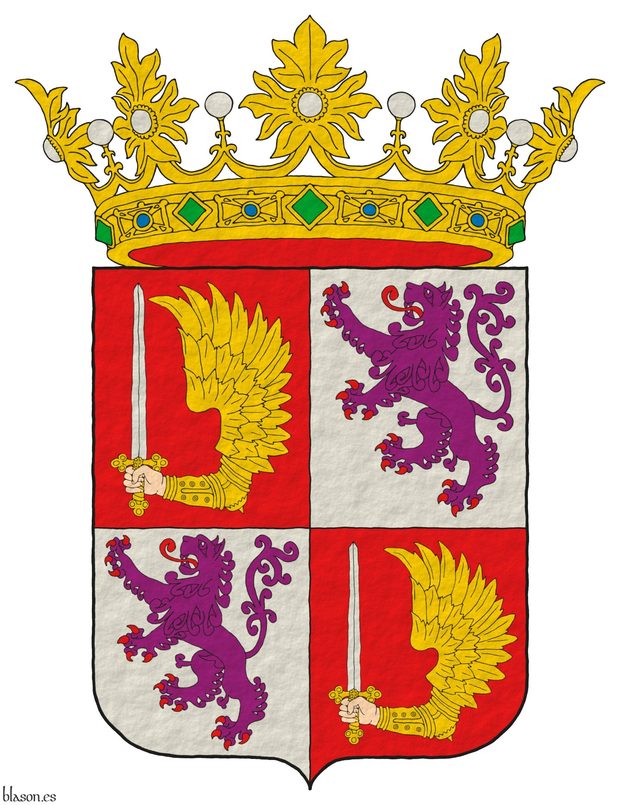
Quarterly: 1 and 4 Gules, a hand Carnation, embowed, vambraced and winged Or, holding a sword point upwards Argent, hilted Or; 2 and 3 Argent, a lion rampant Purpure, armed and langued Gules. Crest: An open royal crown.
Arms interpreted by me, in flat tinctures, contoured in Sable, with an ogee external shape and with a texturized finish.
Coat of arms of the Infante Manuel of Castile, 1234–1283, 7th son of the King Ferdinand III of Castile, 1199-1252, and the Queen Beatrice of Swabia, 1205–1235. This coat of arms has been emblazoned by me with plain colors and metals.
Blazon keywords: Gules, Or, Argent, Purpure, One, Quarterly, Hand, Arm, Vambraced, Embowed, Winged, Sword, Point upwards, Hilted, Lion, Rampant, Armed, Langued, Crest, Open royal crown and Crown.
Style keywords: Outlined in sable, Plain tincture and Ogee.
Classification: Personal, Kingdom of Castile and Leon, Interpreted, Boa and Coat of arms.
Bearer: Manuel of Castile, Infante.


Crown of the Infante Manuel of Castile

Quarterly: 1 and 4 Gules, a hand Carnation, embowed, vambraced and winged Or, holding a sword point upwards Argent, hilted Or; 2 and 3 Argent, a lion rampant Purpure, armed and langued Gules. Crest: An open royal crown.
Coat of arms emblazoned by me, highlighted with lights and shadows, contoured in Sable, with an ogee external shape and with a freehand finish.
Coat of arms of the Infante Manuel of Castile, 1234–1283, 7th son of the King Ferdinand III of Castile, 1199-1252, and the Queen Beatrice of Swabia, 1205–1235. This coat of arms has been emblazoned by me.
Blazon keywords: Gules, Or, Argent, Purpure, One, Quarterly, Hand, Arm, Vambraced, Embowed, Winged, Sword, Point upwards, Hilted, Lion, Rampant, Armed, Langued, Crest, Open royal crown and Crown.
Style keywords: Outlined in sable, Illuminated, Ogee and Freehand.
Classification: Personal, Kingdom of Castile and Leon, Interpreted, Boa and Coat of arms.
Bearer: Manuel of Castile, Infante.


Beatrice of Swabia
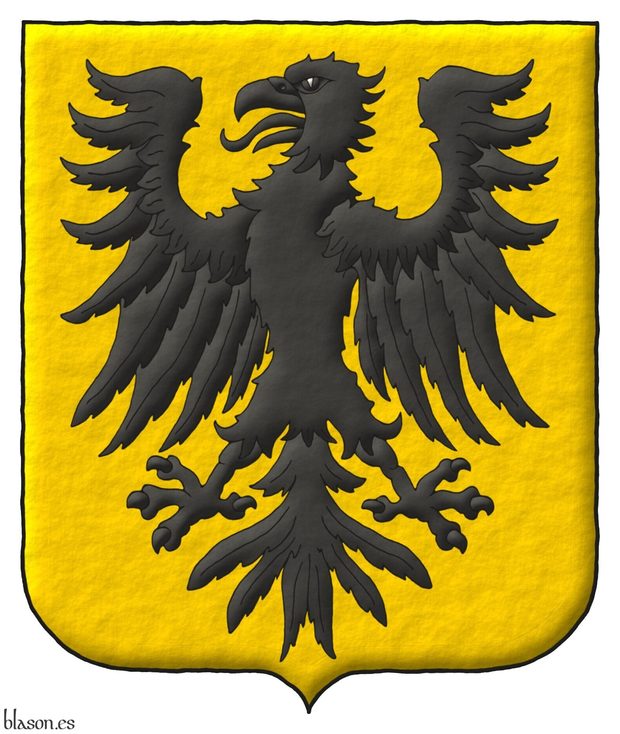
Or, an eagle displayed Sable.
Escudo de oro, un águila de sable.
Coat of arms painted by me, highlighted with lights and shadows, outlined in Sable, with an ogee external shape and with a freehand finishing.
Coat of arms of the Queen Beatrice of Swabia, 1205–1235, baptized as Elisabeth, wife of King Ferdinand III of Castile, 1199–1252. The eagle Sable on an Or field is a distinctive symbol of the Holy Roman Empire. This coat of arms has been emblazoned by me.
Blazon keywords: Or, Sable, One and Eagle.
Style keywords: Outlined in sable, Illuminated, Ogee and Freehand.
Classification: Personal, Interpreted, Boa and Coat of arms.
Bearer: Beatrice of Swabia.


Berenguela of Castile, Infanta

Quarterly: 1 and 4 Gules, a castle triple-towered Or, port and windows Azure, and masoned Sable; 2 and 3 Argent, a lion rampant Purpure, armed and langued Gules; a bordure compony of sixteen sections: eight Gules, a castle triple-towered Or, port and windows Azure, and masoned Sable, eight Or, an eagle displayed Sable.
Escudo cuartelado: 1o y 4o de gules, un castillo de oro, aclarado de azur, mazonado de sable; 2o y 3o de plata, un león rampante de púrpura, armado y lampasado de gules; una bordura componada de dieciseis compones: ocho de gules, un castillo de oro, aclarado de azur, mazonado de sable, ocho de oro, un águila de sable.
Coat of arms emblazoned by me, illuminated with lights and shadows, contoured in Sable, with an ogee outer contour and with a freehand finishing.
Coat of arms of the Infanta Berenguela of Castile, 1228–1279, 5th daughter of the King Ferdinand III of Castile, 1199-1252, and the Queen Beatrice of Swabia, 1205–1235. There are discrepancies regarding the year of her death, with sources suggesting either 1279 or 1288. She bore her father's arms with a bordure compony featuring the arms of Castile and those of her mother, from Swabia. [Menéndez Pidal de Navascués, F.; 1982; page 104 and illustration between pages 112 and 113] writes «We know of a seal of this infanta that displays in the field the royal quarterly, surrounded like a bordure by 4 castles and 4 eagles, alternating», and in the illustration he depicts the bordure with 8 castles and 8 eagles, which is the version I have interpreted. I am particularly fond of compony arms, and this one is, to me, among the most beautiful and quintessentially Castilian.
Blazon keywords: Gules, Or, Azure, Sable, Argent, Purpure, One, Sixteen, Eight, Quarterly, Castle, Triple-towered, Port and windows, Masoned, Lion, Rampant, Armed, Langued, Bordure, Compony and Eagle.
Style keywords: Outlined in sable, Illuminated, Ogee and Freehand.
Classification: Personal, Kingdom of Castile and Leon, Interpreted, Boa and Coat of arms.
Bearer: Berenguela of Castile, Infanta.


Crown of the Infanta Berenguela of Castile
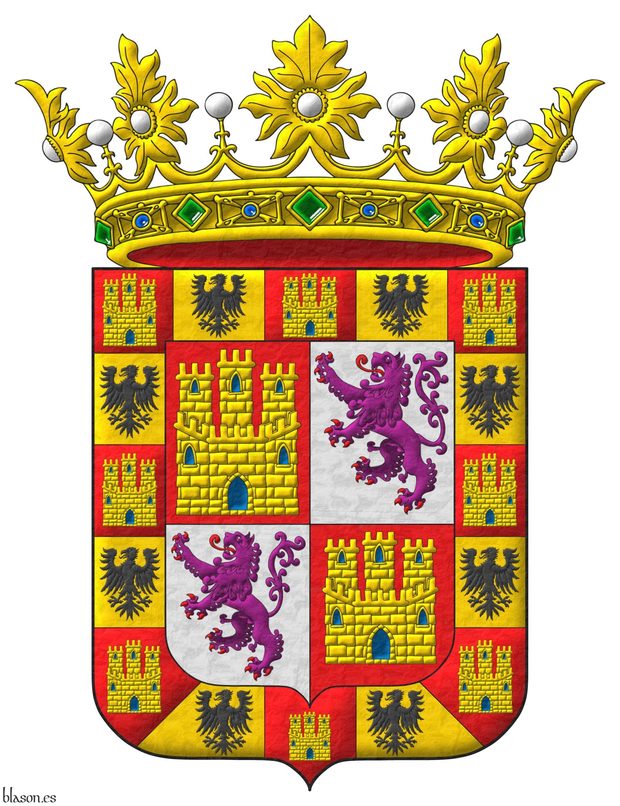
Quarterly: 1 and 4 Gules, a castle triple-towered Or, port and windows Azure, and masoned Sable; 2 and 3 Argent, a lion rampant Purpure, armed and langued Gules; a bordure compony of sixteen sections: eight Gules, a castle triple-towered Or, port and windows Azure, and masoned Sable, eight Or, an eagle displayed Sable. Crest: An open royal crown.
Arms emblazoned by me, illuminated with lights and shadows, contoured in Sable, with an ogee external shape and with a metal beaten finish.
Coat of arms of the Infanta Berenguela of Castile, 1228–1279, 5th daughter of the King Ferdinand III of Castile, 1199-1252, and the Queen Beatrice of Swabia, 1205–1235. The coat of arms of Infanta Berenguela of Castile, besides being beautiful, has always seemed to me the epitome of the Castilian arms: quartered, bearing Leon and Castile, and surrounded by a bordure compony with castles. This coat of arms has been emblazoned by me.
Blazon keywords: Gules, Or, Azure, Sable, Argent, Purpure, One, Sixteen, Eight, Quarterly, Castle, Triple-towered, Port and windows, Masoned, Lion, Rampant, Armed, Langued, Bordure, Compony, Eagle, Crest, Open royal crown and Crown.
Style keywords: Outlined in sable, Illuminated, Ogee and Metal beaten.
Classification: Personal, Kingdom of Castile and Leon, Interpreted, Boa and Coat of arms.
Bearer: Berenguela of Castile, Infanta.

Continue with: Henry of Castile, Infante.
-
Language
-
Categories of heraldry
-
Divisions of the field
- Without divisions
- Party per pale
- Party per fess
- Party per bend
- Party per bend sinister
- Tierce
- Tierce sinister
- Tierced per pale
- Tierced per fess
- Tierced per bend
- Tierced pallwise inverted
- Quarterly
- Quarterly per saltire
- Gyronny
- Party per fess, the chief per pale
- Party per pale, the sinister per fess
- Party per fess, the base per pale
- Party per pale, the dexter per fess
- Chapé
- Chaussé
- Embrassé
- Contre-embrassé
- Party per chevron
- Enté
- Enté en point
- Flanched
-
Metals
-
Colours
-
Furs
-
Other tinctures
-
Ordinaries and sub-ordinaries
-
Diminutives of the ordinaries
-
Other charges
-
Charges from Nature
Water, Eagle, Bald eagle, Eagle claw, Dorsal fin, Tail fin, Two hands clasped, Lark, Tree, Trunk, Rainbow, Atom, Barbel, Acorn, Bighorn sheep, Arm, Owl, Vulture, Horse, Head, Goat, Camellia, Thistle, Merino ram, Kapok tree, Stag, Doe, Crescent, Increscent, Chrysanthemum, Tail, Tail addorsed, Ermine spot, Hummingbird, Snowflake, Heart, Roe deer, Neck, Stags' attires, Roe deers' attires, Raven, Dolphin, Diamond, Tooth, Elephant, Trunk (elephant), Beetle, Emerald, Starling, Mullet, Mullet of four points, Star of David, Estoile, Male figure, Fleur de lis, Flower, Cornflower, Dogwood flower, Lotus flower, Hop cone, Bluebonnet, Puffin, Ash, Rooster, Claw, Talon, Goose, Heron, Seagull, Pomegranate, Sunflower, Swallow-tail, Falcon, Leaf, Boar, Goldfinch, Laurel, Barn owl, Lion, Lioness, Lion passant, Leopard, Lion rampant guardant, Lynx, Lily, Madonna lily, Flame, Wolf, She-wolf, Parrot, Moon, Hand, Apple, Apple tree, Sea, Martlet, Wing, Two wings in vol, Covert, Blackbird, Mount, Trimount, Fly, Wrist, Elm, Olive tree, Orbital, Bear, Palm frond, Palm tree, Dove, Poplar leaf, Panther, Jaguar, Vine, Paw, Forepaw, Foot (palmiped), Foreleg, Peacock, Chest, Pelican, Pelican in her piety, Dog, Brach hound, Warren hound, Fish, Hoof, Beak, Feather, Ostrich feather, Cinquefoil, Quetzal, Branch, Sprig, Frog, Shamrock, Caboshed, Oak, Holm oak, Rose, Double rose, Savage, Serpent, Plough of Ursa Major, Sun, Sun in splendour, Ray of the sun, Lightning flash, River, Stem, Badger, Tyger, Linden, Wheat, Wheat spike, Bull, Tulip, Udder, Escallop and Fox.
-
Artificial charges
Halberd, Plough share, Ace of spades, Anchor, Cyclamor, Torch, Bow, Arch, Harp, Non-classic artifact, Winnowing fan, Crozier, Conductor's baton, Pair of scales, Ship, Oar, Sail, Norman ship, Beret, Grenade, Ecclesiastical cap, Arm vambraced, Knight, Chain, Cup, Covered cup, Monstrance, Bell, Bell tower, Cannon, Cannon dismounted, Cannon port, Carbuncle, Castle, Ribbon, Clarion, Nail, Crucible, Cord, Dagger, Key ward, Turret, With a turret, Armillary sphere, Sword, Federschwert, Sabre, Parchment, Scroll, Skirt, Arrow, Club, Garb, Sheaf of tobacco, Scythe, Gauntlet, Axe, Buckle, Galician granary, Host, Bonfire, Polish winged hussar, Church, Fanon, Oil lamp, Spear, Spear's head, Fleam, Letter, Book, Open book, Closed book, Bookmark, Page, Line, Lantern, Key, Four crescents joined millsailwise, Hammer, Two-handed sword, Menorah, Mortar, Pestle, Number, Knot, Celtic Trinity knot, Water-bouget, Comb, Piano, Millstone, Millrind, Millwheel, Quill, Clay pot, Potent, Bridge, Cuffed, Hourglass, Chess rooks, Compass rose, Rosette of acanthus leaves, Mullet of six points pierced, Broken, Portcullis, Wheel, Wagon-wheel, Symbol, Sackbut, Drum, Loincloth, Geometric solid, Tetrahedron, Tower, Trident, Trumpet, Double vajra and Anvil.
-
Immaterial charges
Angel, Archangel, Basilisk, Heart enflamed, Sacred Heart of Jesus, Paschal lamb, Dragon's head, Dragon, Wyvern, Phoenix, Garuda, Griffin, Sea-griffin, Winged hand, Our Lady of Mercy, Pegasus, Saint George, Mermaid, Trinity, Triton, Golden fleece, Unicorn and Ouroboros.
-
External elements
-
Heraldic creations
-
References
-
Formats
-
Keywords on this page
Port and windows, Winged, Point upwards, Armed, Vambraced, Azure, Beatrice of Swabia, Berenguela of Castile, Infanta, Boa, Bordure, Arm, Castle, Crest, Compony, Ogee, Crown, Open royal crown, Cross flory, Cross couped, Quarterly, Embowed, Triple-towered, Outlined, Outlined in sable, Sixteen, Coat of arms, Sword, Schema, Personal, Hilted, Gules, Illuminated, Interpreted, Langued, Lion, Hand, Manuel of Castile, Infante, Masoned, Eight, Or, Argent, Purpure, Rampant, Kingdom of Castile and Leon, Sable, Design rationale, Freehand, One and Eagle.
